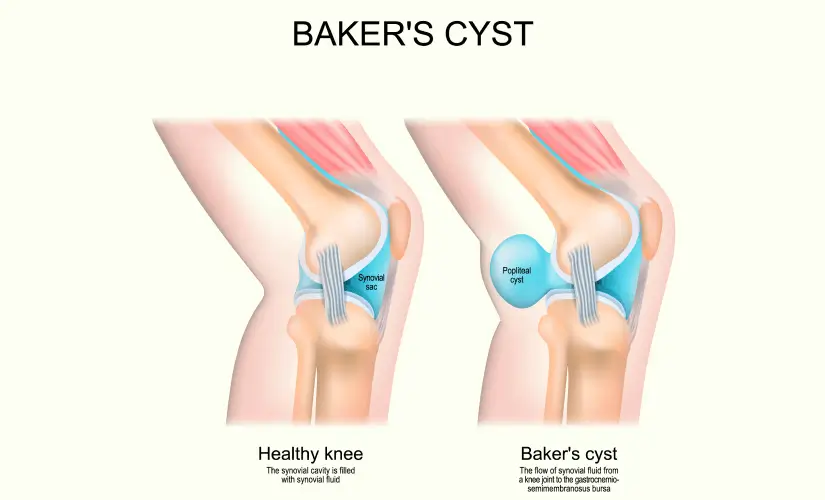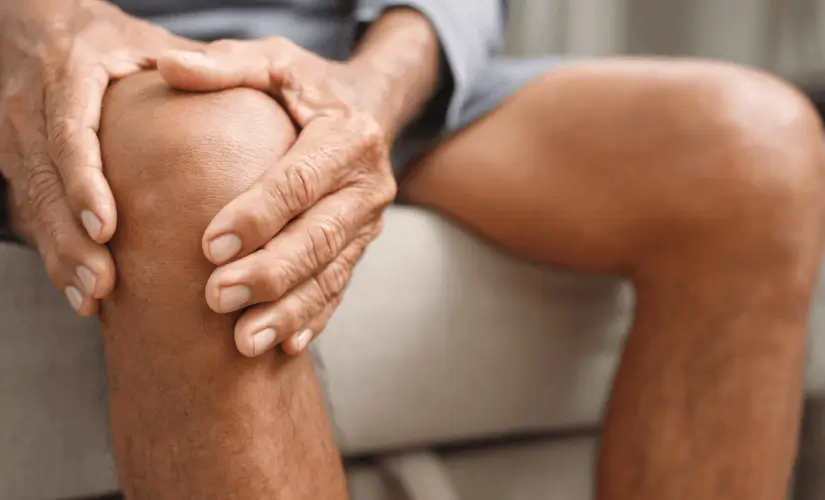-
Doctors
-
Specialities & Treatments
Centre of Excellence
Specialties
Treatments and Procedures
Hospitals & Directions HyderabadCARE Hospitals, Banjara Hills CARE Outpatient Centre, Banjara Hills CARE Hospitals, HITEC City CARE Hospitals, Nampally Gurunanak CARE Hospitals, Musheerabad CARE Hospitals Outpatient Centre, HITEC City CARE Hospitals, Malakpet
HyderabadCARE Hospitals, Banjara Hills CARE Outpatient Centre, Banjara Hills CARE Hospitals, HITEC City CARE Hospitals, Nampally Gurunanak CARE Hospitals, Musheerabad CARE Hospitals Outpatient Centre, HITEC City CARE Hospitals, Malakpet Raipur
Raipur
 Bhubaneswar
Bhubaneswar Visakhapatnam
Visakhapatnam
 Nagpur
Nagpur
 Indore
Indore
 Chh. Sambhajinagar
Chh. SambhajinagarClinics & Medical Centers
Book an AppointmentContact Us
Online Lab Reports
Book an Appointment
Consult Super-Specialist Doctors at CARE Hospitals

Baker's Cyst
Symptom, Causes, Diagnosis and Treatment
Baker's Cyst
If you've ever experienced discomfort or a lump behind your knee, you might have encountered a Baker's cyst. Understanding this condition, including its symptoms and the various available treatment options, is crucial for managing discomfort and preventing potential complications. While often manageable, it can significantly affect your daily activities and overall quality of life. Recognising Baker's cyst symptoms and signs early on can result in a more effective management of the condition.

What is a Baker's Cyst?
Baker's cyst, also called a popliteal cyst, is a fluid-filled pouch that develops at the back of the knee joint. It is one of the most common disorders affecting the knee. These cysts form a lump behind the knee, often causing stiffness and discomfort.
The condition is named after the 19th-century surgeon Dr. William Morrant Baker, who first described it. Baker's cyst in the knee joint typically results from an underlying problem within the joint. Some of these conditions can be osteoarthritis or a meniscus tear, which can cause the joint to produce excess fluid and ultimately lead to cyst formation.
Baker Cyst Symptoms
The most common symptoms associated with a Baker's cyst include:
- The primary symptom is a noticeable swelling or lump at the back of your knee joint.
- You may experience pain and stiffness in the affected knee, especially when bending or straightening the joint.
- In some cases, a Baker's cyst can cause occasional locking or clicking sensations when moving the joint.
- If a Baker's cyst ruptures or bursts, the fluid can leak down into the calf area, causing sudden sharp pain, swelling, and redness.
Causes of Baker Cysts
Baker's cysts can develop due to underlying conditions or injuries affecting the knee joint. The primary causes include:
- Arthritis: Different types of arthritis can result in the formation of a Baker's cyst. The most common forms are:
- Osteoarthritis
- Rheumatoid arthritis
- Gout
- Knee Injuries: Common knee injuries that may lead to cyst formation include:
- Repetitive strain injuries (overuse injuries)
- Meniscus tears
- Hyperextensions
- Sprains
- Dislocations
- Bone fractures
- Ligament Damage: Injuries that damage the knee ligaments can also contribute to the formation of Baker's cysts, such as:
- ACL (Anterior Cruciate Ligament) tears
- MCL (Medial Collateral Ligament) tears
- LCL (Lateral Collateral Ligament) tears
- PCL (Posterior Cruciate Ligament) tears
Diagnosis
The diagnosis of a baker cyst typically involves the following steps:
- Medical History: The doctor will ask about symptoms such as knee pain, stiffness, and swelling, as well as any history of knee injuries or conditions like arthritis.
- Physical Assessment: The doctor will look for the characteristic swelling or lump at the back of your knee joint. They may also evaluate your knee's range of motion and check for any associated pain or discomfort.
- Imaging Tests:
- Ultrasound: This is commonly used to confirm the presence of a Baker's cyst.
- MRI (Magnetic Resonance Imaging): An MRI provides detailed images of the knee joint and can help rule out conditions like blood clots, aneurysms, or tumours.
- X-ray: Although X-rays cannot detect cysts directly, they can identify conditions like arthritis that may be contributing to their formation.
- Aspiration: Sometimes, the doctor may use a needle to remove fluid from the cyst for analysis to rule out other conditions.

Baker’s Cyst Treatment
The treatment approach for a Baker's cyst depends on the severity of your Baker's cyst signs and symptoms and the underlying cause.
- Non-Surgical Treatment:
- Over-the-counter pain reducers can help reduce pain and inflammation.
- Resting the affected knee and avoiding physical activities that aggravate the symptoms can help alleviate discomfort and prevent further irritation.
- A cold pack or a bag of ice cubes which you can wrap in a towel to the affected knee for 10-20 minutes can help reduce swelling and pain.
- Wearing a knee support or compression sleeve and keeping the affected leg elevated can help minimise swelling and discomfort.
- Gentle exercises and stretches prescribed by a physical therapist can improve the range of movement, strengthen the muscles around the knee, & promote healing.
- Surgical Treatment: While many Baker's cysts resolve on their own, surgery may be considered in certain situations:
- Persistent or Recurrent Cysts: If the cyst continues to cause pain or discomfort despite non-surgical treatments.
- Large Cysts: If the cyst is significantly large and causing significant pressure or discomfort.
- Ruptured Cysts: If the cyst has ruptured and is causing inflammation or bleeding.
- Associated Joint Conditions: If the cyst is associated with underlying joint problems, such as arthritis or a meniscus tear.
- Neurovascular Compromise: In rare cases, a large cyst can compress nearby nerves or blood vessels, requiring surgical intervention.
- The surgical options include:
- Aspiration: In this procedure, the doctor will drain the fluid from the baker cyst using a needle under ultrasound guidance.
- Arthroscopic Surgery: If Baker's cyst is caused by an underlying knee joint problem, such as a meniscus tear or cartilage damage, doctors may perform arthroscopic surgery to repair the issue.
- Cyst Removal: In rare cases, when other treatment options have failed, and the cyst continues to cause significant discomfort or impair mobility, surgical removal of the cyst may be recommended.
Risk Factors
While anyone can develop a Baker's cyst, certain factors increase your chance of developing it. The primary risk factors include:
- Age: Baker's cysts tend to occur most commonly in adults aged 35 to 70.
- Joint Diseases: You are at a higher risk of developing a Baker's cyst if you have an underlying inflammatory joint disease, such as rheumatoid arthritis and osteoarthritis.
- Knee Injuries: Common knee injuries that may lead to cyst formation include:
- Cartilage or meniscus tears
- Overuse injuries or repetitive strain
- Sprains, dislocations, or bone fractures
Complications
While Baker's cysts are generally harmless, they can sometimes lead to complications if left untreated. The potential complications of a Baker's cyst include:
- Cyst Rupture: One of the most common complications is cyst rupture, which occurs when the fluid-filled sac bursts. This can cause:
- Sharp, sudden pain in the knee and calf area
- Significant swelling and redness in the calf
- Stiffness and limited mobility in the affected leg
- Restricted Knee Movement: If the Baker's cyst grows large enough, it can restrict the movement of the affected person's knee joint, leading to:
- Difficulty bending or straightening the knee
- Knee stiffness and discomfort
- Potential instability or locking of the knee joint
- Nerve Compression: In some cases, a Baker's cyst can compress the nerves that run behind the knee joint, leading to:
- Numbness or tingling sensations in the calf or foot
- Weakness or loss of muscle control in the troubled leg
- Shooting pains down the leg
- Blood Clot Formation: Although rare, a Baker's cyst can lead to blood clot formation (deep vein thrombosis or DVT) in the affected leg.
When should I see a doctor?
If you have a lump behind your knee that is causing problems and does not go away on its own, you should see your doctor.
Prevention
There are several steps you can take to lower your risk of developing one or prevent its recurrence. Some of the self care tips are:
- Prevent Knee Injuries: Avoiding knee injuries is the best way to prevent the formation of Baker's cysts. To minimise the risk of knee injuries, consider the following:
- Wear supportive, well-fitting shoes during physical activities.
- Warm up properly before exercise or sports and cool down afterward.
- Refrain from exercising or putting excessive strain on a knee that is already tender or painful.
- Manage Underlying Conditions: If you have an underlying systemic condition, such as arthritis or gout, that increases your risk of developing a Baker's cyst, it's essential to manage it effectively.
- Maintain a Healthy Weight: Excess body weight can put additional stress on your knees, enhancing the risk of joint damage and forming Baker's cysts.
- Strengthen Knee Muscles: Engaging in exercises that strengthen the muscles surrounding your knees can provide better support & stability to the joint, potentially reducing the possibility of developing a Baker's cyst.
Conclusion
The impact of Baker's cysts extends far beyond mere discomfort, potentially affecting our daily activities and overall well-being. This underscores the critical need for increased awareness and education surrounding this condition. By understanding the risk factors and preventive measures, we empower ourselves to proactively take charge of our joint health. Regularly attend follow-up appointments to monitor the cyst’s progress. This ensures timely intervention if the cyst grows, causes increased pain, or affects your mobility.
FAQ's
1. How long does a Baker cyst last?
Most Baker's cysts go away within a few weeks as the swelling subsides and your knee starts to heal. However, if an underlying condition like arthritis causes the cyst, it may persist until the root issue is addressed.
2. What happens if you leave a Baker cyst untreated?
Leaving a Baker's cyst untreated can lead to complications like cyst rupture, restricted knee movement, nerve compression, or blood clot formation.
3. Do Baker's cysts need to be removed?
Surgical removal of a Baker's cyst is rarely necessary. Doctors may recommend surgery if the cyst is causing severe pain or significantly limiting your ability to walk or perform other activities and other treatment options have been ineffective.
4. Can you get rid of a Baker's cyst naturally?
Sometimes, a Baker's cyst may resolve on its own; several home remedies can help manage symptoms. Rest, ice, compression, and elevation (RICE) can reduce swelling. Gentle knee exercises and anti-inflammatory foods or supplements may alleviate discomfort. However, consult a doctor for persistent or severe cases.
5. Is walking good for a Baker's cyst?
Walking can be beneficial for a Baker's cyst, but it depends on the severity of your condition. If the cyst is responsible for severe pain or limiting your mobility, you may need to temporarily reduce physical activity to allow the knee to rest and recover. However, once the acute symptoms subside, gentle walking can help regain strength and improve the range of motion in the affected knee joint.
Still Have a Question?




